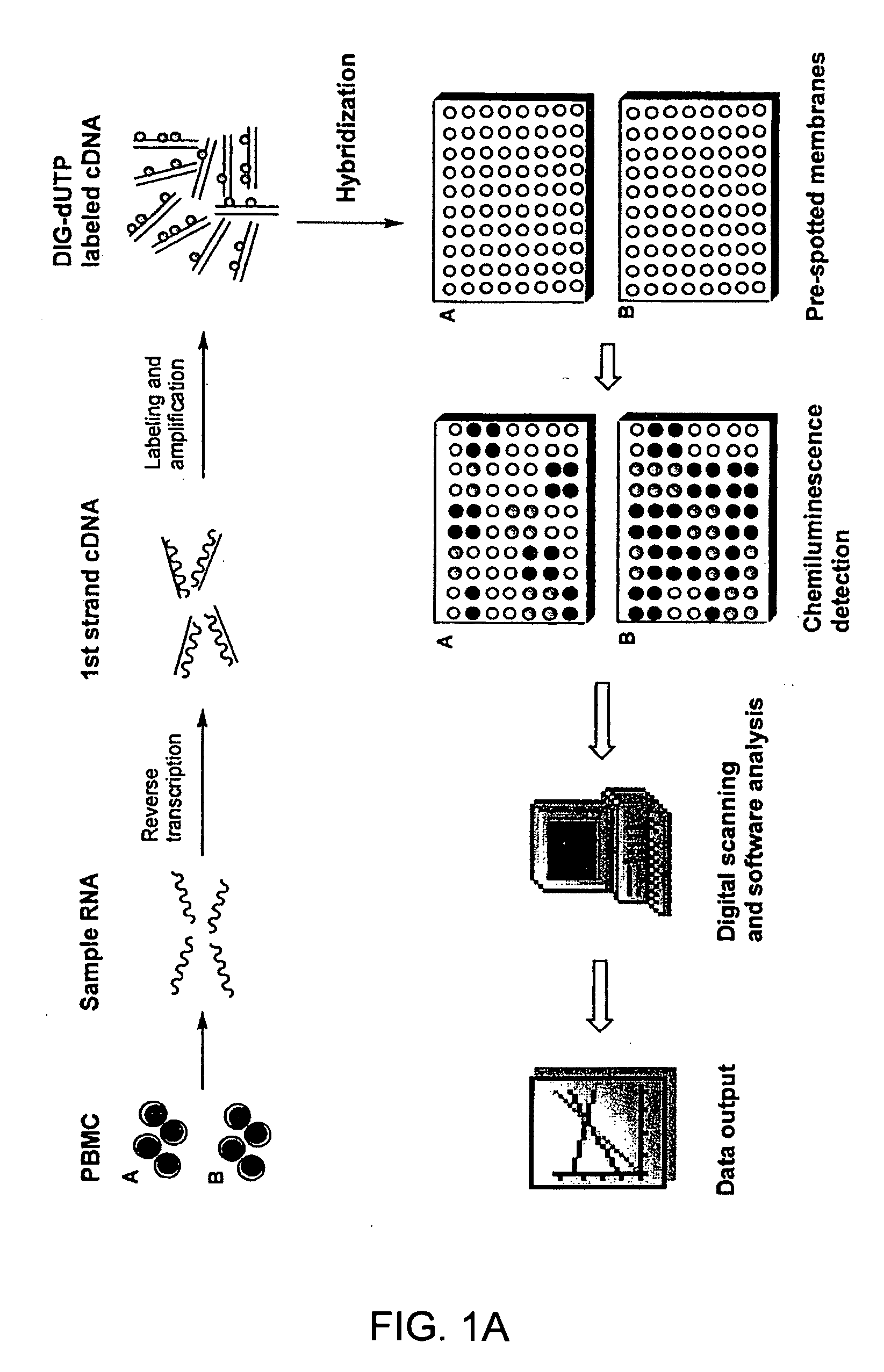Gene expression profiling technology for treatment evaluation of multiple sclerosis
a gene expression and multiple sclerosis technology, applied in the field of molecular biology, genetics, medicine, can solve the problems of limited routine and frequent utility of treatment monitoring in ms, loss of valuable treatment time window, and difficulty in timely evaluation of the treatment effect of both beta-ifn and ga in ms patients
- Summary
- Abstract
- Description
- Claims
- Application Information
AI Technical Summary
Benefits of technology
Problems solved by technology
Method used
Image
Examples
example 1
Patients and Blood Specimens
[0131] Thirty patients with either relapsing-remitting MS or secondary progressive MS were studied. The first batch of blood specimens was taken from fifteen patients who had not been treated with beta-IFN or GA for at least 24 months prior to the study. The second batch of blood specimens was taken from thirty patients who had received treatment with either beta-IFN-1a (Avonex® or Rebif®) or GA for 2-8 years. A group of 9 healthy volunteers (6 female and 3 male individuals) were included to provide preparation of peripheral blood mononuclear cells (PBMC) as indicator cells for gene expression profiling by in vitro treatment of the drugs.
example 2
In Vitro Treatment of PBMC with Beta-IFN or GA and Serum Neutralizing Antibody
[0132] Culture medium used in the study was RPMI-1640 supplemented with 10% heat-inactivated fetal calf serum and L-glutamine, sodium pyruvate, non-essential amino-acids, and 10 mM HEPES buffer (Hyclone, Logan, Utah). Beta-IFN and GA used in this study were obtained from Berlex (Richmond, Calif.) and Teva pharmaceuticals (Kansas City, Mo.), respectively. PBMC were prepared by Ficoll density gradient centrifugation and resuspended in 5% FCS RPMI 1640. For in vitro treatment with beta-IFN or GA, 107 cells were cultured in the presence of 1.5 ng / ml beta-IFN or 50 μg / ml GA for 6, 12, 18 and 24 hours in a humidified atmosphere of 5% CO2 at 37° C. It was determined in a series of pilot experiments that a 24-hour incubation time yielded best gene expression profiling results. PBMC cultured under the same conditions in the absence of the drug served as a control. Subsequently, cells were collected for RNA prepara...
example 3
[0133] RNA Isolation
[0134] Total RNA was isolated from PBMC specimens using the RNeasy kit (Qiagen, Valencia, Calif.) according to the manufacturer's instructions. To obtain high quality RNA, contaminating DNA was efficiently removed from RNA samples by digestion with DNase I (Qiagen, Valencia, Calif.) in the process of RNA isolation. The integrity of isolated RNA was verified on a gel prior to cDNA probe labeling.
PUM
| Property | Measurement | Unit |
|---|---|---|
| Fluorescence | aaaaa | aaaaa |
Abstract
Description
Claims
Application Information
 Login to View More
Login to View More - R&D
- Intellectual Property
- Life Sciences
- Materials
- Tech Scout
- Unparalleled Data Quality
- Higher Quality Content
- 60% Fewer Hallucinations
Browse by: Latest US Patents, China's latest patents, Technical Efficacy Thesaurus, Application Domain, Technology Topic, Popular Technical Reports.
© 2025 PatSnap. All rights reserved.Legal|Privacy policy|Modern Slavery Act Transparency Statement|Sitemap|About US| Contact US: help@patsnap.com



